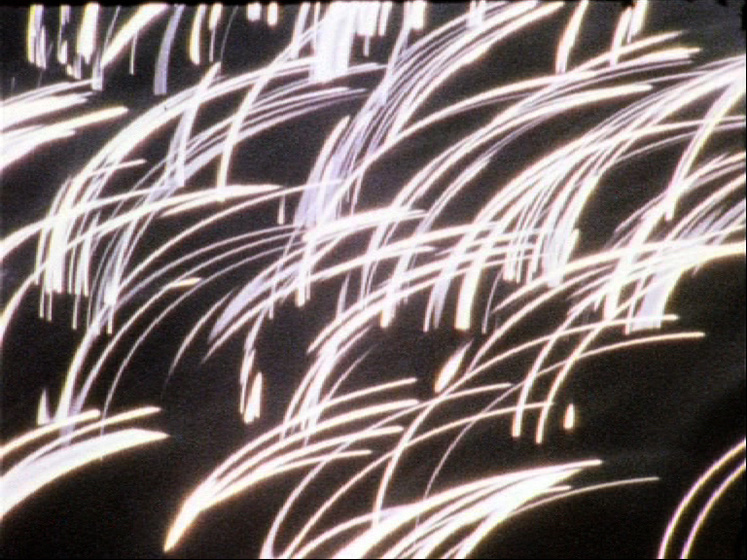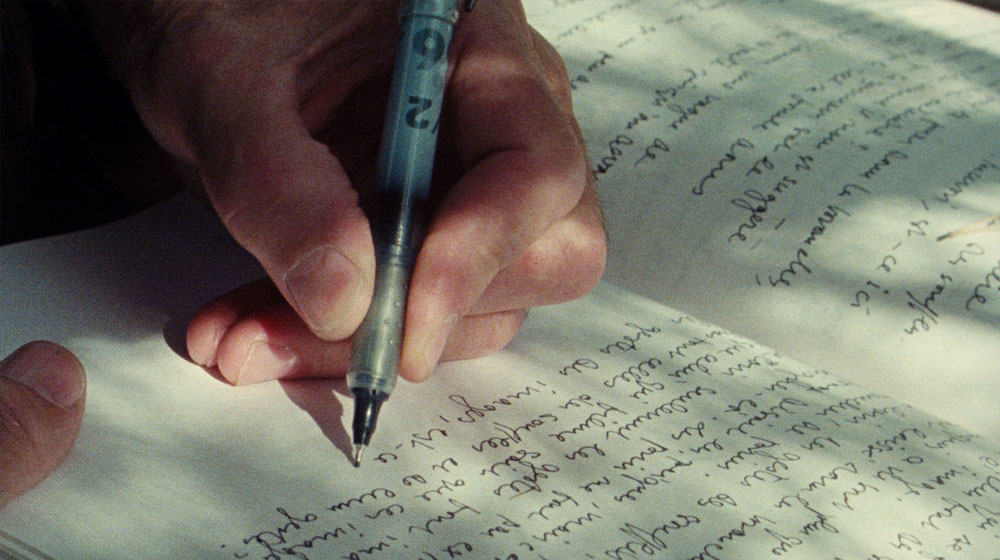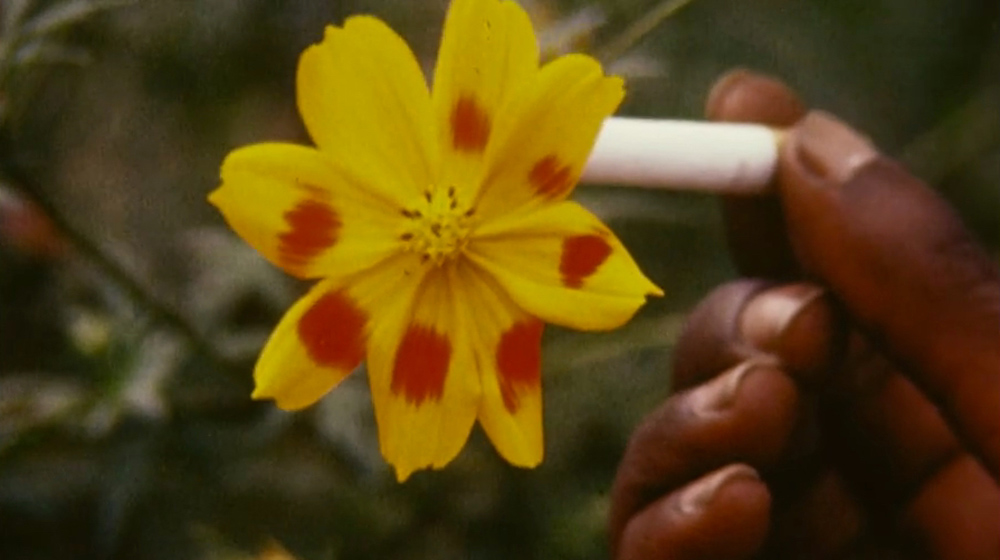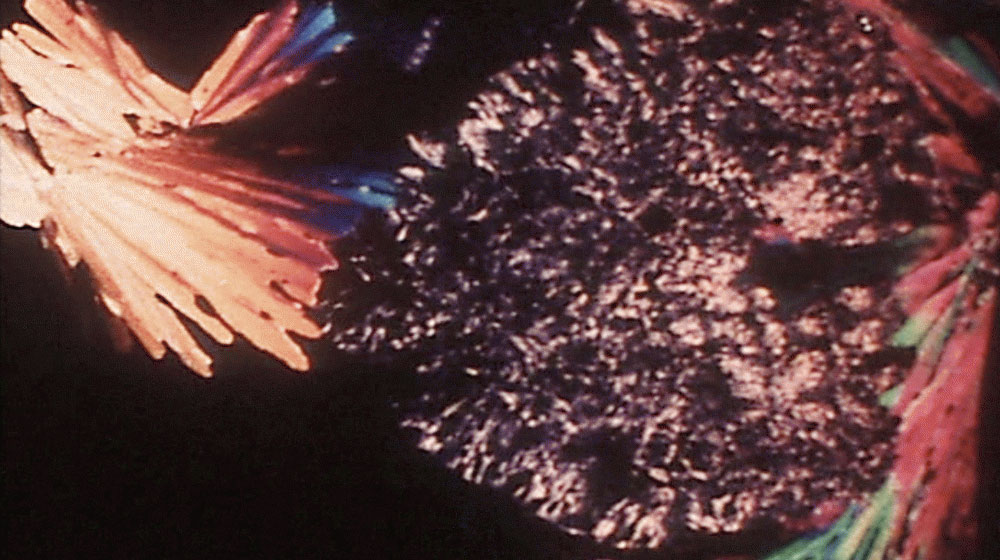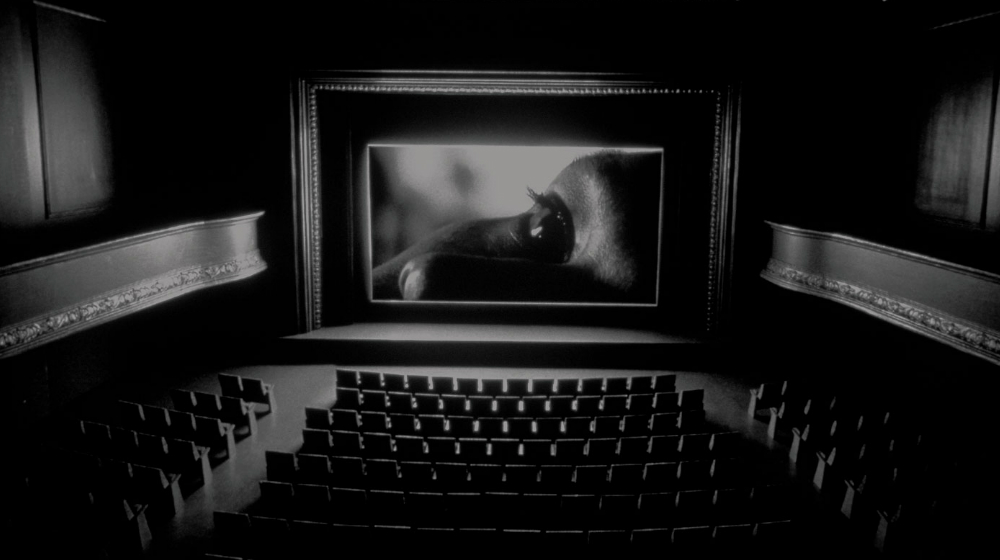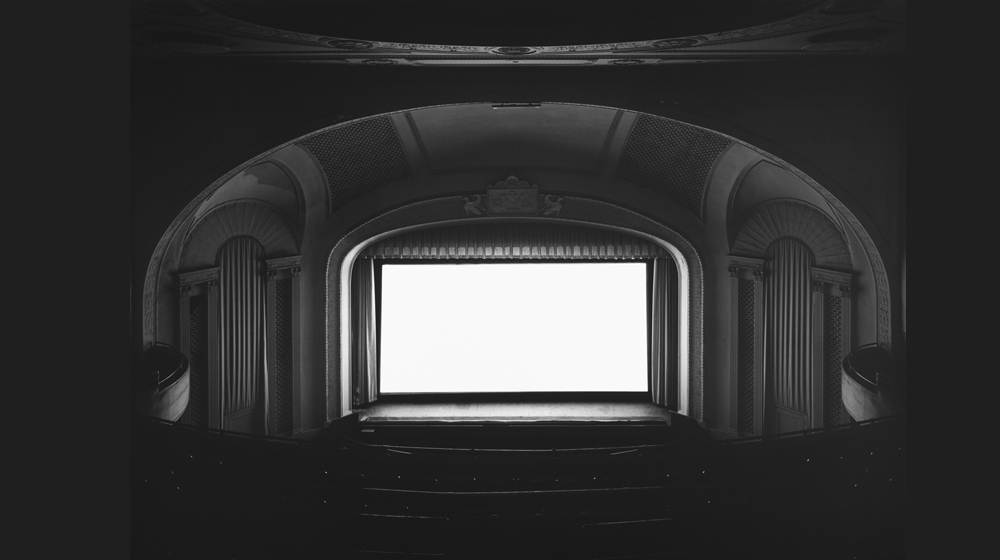The eye must be something like the sun, otherwise no sunlight could be seen
Goethe
the last sun is an eye
illuminated towards the night
Juan Bufill
Epigraph
We’ll begin by clarifying the title of the text, which is also the name of the Xcèntric session dedicated to the cineaste and poet Juan Bufill, screening some of his films that revolve around light, colour and movement. In fact, “sun eye” comes, as the filmmaker explains, from a saying by Plotinus, “Never could the eye have looked upon the sun had it not become sun-like”,[1] which Goethe paraphrased and developed in his Theory of Colours (1810). It was probably this intuition by Plotinus that led the German writer to reverse Newton’s optics, introducing the body of the observer as an active element in seeing. Goethe didn’t define light mechanically but placed it within the unstable physiology of the eye to be able to perceive its multiple nature, establishing such an affinity that the contours became confused. This sun eye is formed under and for light so that its inner light can flow together with the external.[2] The seeing performed by this eye is no longer in the crystalline, transparent terrain of optics but distant, in what Goethe calls the turbid, cloudy or shadowy.[3] Such reflections allow us not only to explain the expression sun eye but also to elucidate some of the paths of perceptive experimentation undertaken by Juan Bufill in his films, where echoes of many of these issues can be found.
poems are the music of images
that illuminate the inner with the outer
and the outer with the inner
Juan Bufill
Poems and songs
In addition to being a filmmaker, Juan Bufill (Barcelona, 1955) is also a poet. He first started writing and filming with a borrowed Super 8 camera in the mid-70s. At that time his idea was to create a film made up of small fragments, which he called Cuadros y canciones [Pictures and songs], the cinematographic equivalent of a record made up of songs or a series of displayed pictures or poems that create a dialogue with each other. We asked him if this project could be related to Mussorgsky’s Pictures at an Exhibition (1874), a series of pieces for piano reminiscent of an exhibition of paintings. Without confirming or rejecting this, Bufill explained that its origin lies in listening to Another Green World (1975) by Brian Eno. The places and stories of the songs from this album suggested ideas to him and places to film: a forest, sand, sea, among other micro-landscapes.
‘I wanted to compose visual songs, landscapes with cinematographic tones, variations and rhythms. Making poetry without words, with abstract, silent images.’ The model used by Bufill to create a lot of these works was the haiku, a form of poetry that summarised, during these years, his perception of film. For the cineaste, these brief poems made up of just three lines, whose fundamental element is the juxtaposition of images and ideas (kiru), many of them with references to nature and its seasons (kigo), were the pattern used to make his first minimalist films, exploring the colour and texture of a landscape.
Cuadros y canciones was never completed. Only five shorts resulted from this work, including Green (1978), Arena (1979) and Paraíso (1978), shown at the São Paulo Biennial and at the Georges Pompidou Centre. After being screened in Paris in 1982, the only copies of these works on film were lost, only being recovered years later with the restoration of a copy on video. Bufill told us all the details, shrugging his shoulders. We inquired whether the Sun eye screening could provide us with some idea of that unfinished project. Although he agreed with this observation, he also added that a programme he made for TV3’s Arsenal might have also resulted from this incomplete work.[4] The programme is El viatge de Robert Wyatt (1987) [The Journey of Robert Wyatt], a work that combined some of his films with songs by the English musician, on the themes of water and sun.
within the green there’s a sun
Juan Bufill
Landscape as a poem
Juan Bufill’s cinema is related not only with the haiku but also with poetry in a broad sense, with the celebration of beauty and the mystery of the world. ‘Poetry can be created with the sound of words but also with the rhythm of film and its images, working with the specific tools of the medium of cinema.’ And for the cineaste, what is specific about cinema isn’t the different shots but what happens between one frame and the next, the possibility of change.[5] In that fleeting relationship between two frames, perceptive adventures occur that allow us to discover the world.
His poem “Los lectopores” speaks of some of the paths of perceptive experimentation tried out by Bufill in his films. Here is a fragment: “ven signos en las nubes / sucesos en las piedras / novelas en los gestos o en las olas: / en el paisaje ven frases / (coordinadas, subordinadas, fragmentadas)”.[6] The possibility of interpreting the landscape as if its different forms were signs is present both in his films and also in his poetry, but the camera radicalises and materialises this quest. His capacity to penetrate reality, to isolate and multiply it allows him, for instance, to discover the symbols hidden within a micro-landscape of moving water under the sun (Invisible visible (la luz animal), 2004-2014) or using light to draw points and lines, creating a dance from vision (Sunny Swing, 2010).
The changing, fleeting image of light reflected on water is one of the main themes in Bufill’s cinema. ‘The first time I captured those signs in perpetual movement was on the Yugoslavian coast in 1978, using a Super 8 without zoom. This vision was a kind of hypnotic pause in my film Frontera’.[7] The theme of water and sun also appears in El río de María (1987), Ver piedras/Signos de sol (1988), in the programme dedicated to Robert Wyatt or in Ver instantes (el río) (2004-2014), and at the same time in different series of photographs taken by the cineaste, such as Escrituras naturales. In Invisible visible (la luz animal) Bufill creates a dialogue between images in movement of a mountain river with the same still images, so that ‘what was an imprecise dance in the film then appears as fixed clearly in the photograph, allowing us to discover forms, figures and signs in each instant that were previously invisible’.
their houses are of stone
their temples are the rocks
their songs merely aspire to silence
Juan Bufill
Architectures
There’s tension between the opposing principles that run throughout Bufill’s films. This tension between interior-exterior, light-shade, solid-liquid, presence-absence and dynamism-stillness has been present since his earliest films and act as a kind of inner heartbeat. Perhaps that’s why most of his films are silent, allowing this dynamism of forces to be perceived in their images, fluctuating between the stable and the mutable and what the cineaste calls “slipping and fixing”. In Ver piedras/Signos de sol, what is solid doesn’t give rise to permanent constructions but to formations that change over time, whereas in Colorespacio (1979) the building is literally in the air, delineating a place by bringing together different chromatic configurations in the sky at different times of the day. This takes Bufill away from Newton and once again brings him closer to Goethe and the ancient Greeks, for whom the tones of the sky were not blue but rather changing, analogous to the photochemical warmth of the grain vibrating within the film.
Likewise, in the Architectures series, the filmic forms are related to those of constructions, introducing dynamism into their structures. It’s a set of portraits of archetypal places such as a bridge, a garden, museum or pyramid, where the mode of filming does not attempt to describe but rather to adjust to each form of building. In Pirámide (2002-2019) the filmmaker translates the play created by the diagonals traversing the building and its symbolic relationship with the sun. In Museo (2003-2019) he films the Bilbao Guggenheim organically and fluidly, presenting its tiles as if they were fish scales reflecting chromatic vibrations. This animism of spaces takes on unusual dimensions in Villa Dionisia (2003-2019), where a family house is portrayed as a metaphor for cinematographic apparatus. The continuous coming and going of lights and shadows illuminates the interior of the house and links it to the exterior - a garden table, a dish with red fruits, a forest path leading to a lake where two children are moving around at the end of summer - assembling memories and childhoods.
Juan Bufill had already filmed his most immediate surroundings with a bias towards strangeness in Colors (1976), a fragment from the collective film En la ciudad,[8] which had urban space as its theme and in which Eugeni Bonet, Antoni Muntadas, Iván Zulueta, Eugènia Balcells, Valcárcel Medina and Eulàlia Grau, among others, also took part, a post-Franco generation that was curious about non-narrative, experimental cinema. Colors is an attempt to portray Barcelona using an instrument that regulates urban space, the traffic light. The change from red to green gives way to images of the suburbs, where the filmmaker found the remains of a desolate industrial area: the mouth of the Rec Comtal river in Bogatell, an abandoned factory and a rubbish dump. Unlike in Villa Dionisia, there are hardly any folds in these places for memory to grab hold of. To remedy this in some way, Bufill added that, during those years in Barcelona, there was a lot of experimental cinema at the Filmoteca on Calle Mercaders, at the North American Institute and the German Institute. ‘Many of us who went to those screenings, besides making films, also set up the Film Vídeo Informació (FVI), a platform aimed at disseminating experimental film and video that even produced a publication’. Its main members, along with Bufill, were Bonet, Balcells and Huerga, although Ignacio Julià and Carles Hac Mor also took part. ‘We organised some exceptional activities such as the presentation of Line Describing a Cone by Anthony McCall, and a screening by Philippe Garrel with live music by Nico. The FVI split up in 1979: Huerga and I had to go to Madrid to do our military service, Balcells returned to New York that year’, he concludes.
time gradually appeared
origin in flight, burst
vast dispersion in space
Juan Bufill
Postscript
This text has been taken from several conversations with Juan Bufill in which Oriol Sánchez also participated, from reading his poetry books Subespecies humanas (1992) and Antinaufragios (2014) and from various texts written by the cineaste about his films.
Celeste Araújo
[1] Cirlot, Juan-Eduardo, Diccionario de símbolos, Editorial Labor, Barcelona, 1992, p. 339.
[2] Cf. Goethe, Esbozo de una teoría de los colores, in Obras completas, volume VII, Aguilar, Barcelona, 1957, pp. 9-244.
[3] Cf. Crary, Jonathan, Técnicas del observador: visión y modernidad en el siglo xix, Cendeac, Murcia, 2008, pp. 97-105.
[4] Juan Bufill was one of the creators of the TV3 programme Arsenal together with Manuel Huerga and Jordi Beltran.
[5] This notion is taken from a course given remotely by Werner Nekes in Barcelona at the end of the seventies.
[6] Bufill, Juan, Subespecies humanas, Ediciones 62, 1992, p. 14. [they see signs in the clouds / happenings in the stones / novels in gestures or waves: / in the landscape they see phrases / (coordinated, subordinated, fragmented).]
[7] Frontera (1978) is one of the films by Juan Bufill that was lost after being screened at the Pompidou Centre in 1982. Only a fragment of this piece is preserved, which was included in the programme Arsenal, entitled “Souvenir” (TV3, 1985).
[8] En la ciudad was a collective film that came out of an initiative by Eugeni Bonet and José Miguel Gómez at the beginning of 1976.
